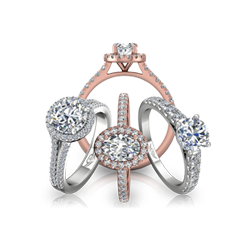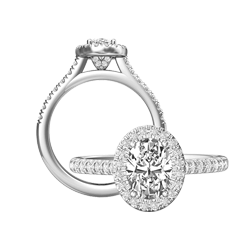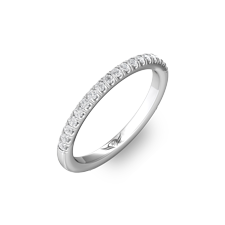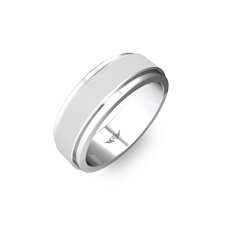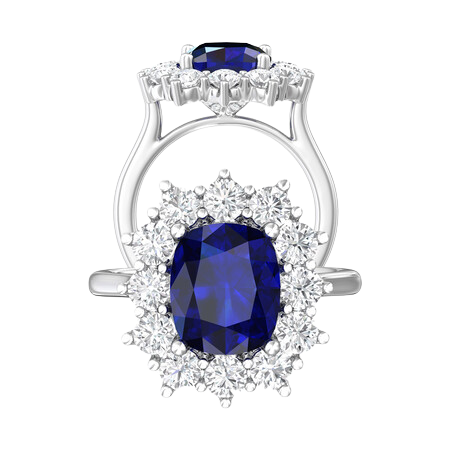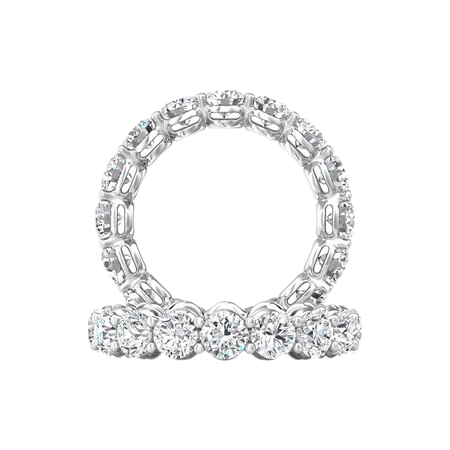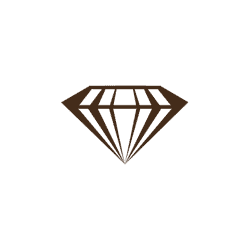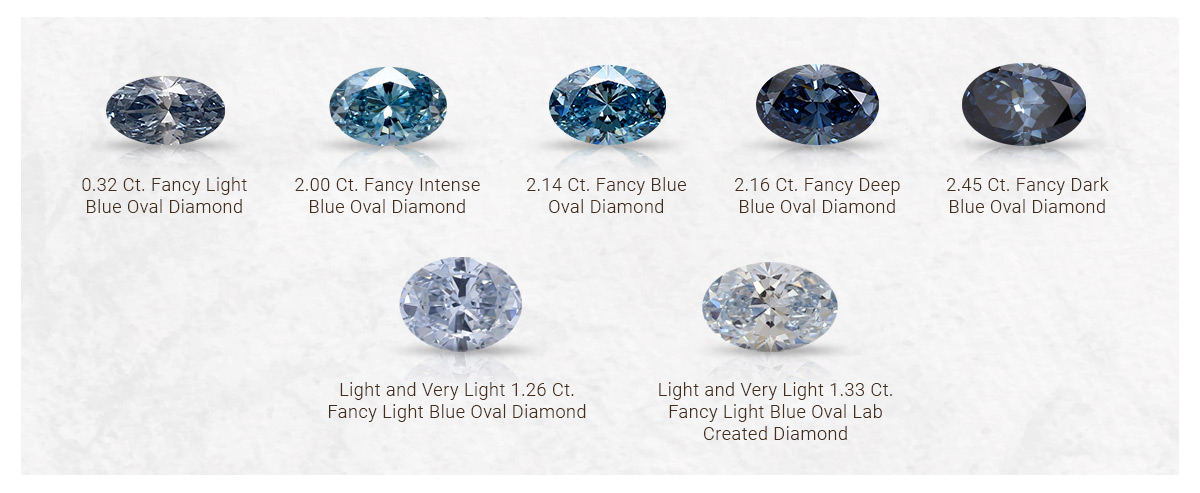A Complete Guide to Diamond Color and Grading
Before you start shopping, it becomes important to understand the 4Cs especially the color of the diamond. Even in a clear diamond, there are a few traces of color within its crystal structures. Most diamonds include nitrogen as the common trace element. When nitrogen atoms replace 1 out of every 10,000 carbon atoms, the diamond picks up a slight yellow tint.
The color darkens when the nitrogen concentration rises to 10 in 10,000 atoms. Similarly, Boron’s traces are responsible for some blue diamonds. So, a diamond’s color, though it may not get as much attention as its carat or cut does, but has a significant impact on its price and value.
What is the diamond color scale?
The diamond color scale was created in order to categorize diamonds based on their color quality, which is determined by their clarity. In general, the less color a diamond has, the higher is its value. Colored diamonds, such as pink and blue diamonds are exceptions to this and are not included in the diamond grading system devised by the Gemological Institute of America (GIA) since they are not considered to be of gem quality.
Using the GIA diamond color grading method, you can determine whether a diamond is slightly colorless or has no color at all. Diamonds with a yellow or brown tint have a poorer color grade and are therefore less valuable in the form of jewelry. Furthermore, in order to determine a diamond’s color grade, an expert compares the diamond to a reference stone having the same color grade under controlled and standardized lighting conditions.
Understanding the diamond color scale

In order to assess a diamond’s color grade, each stone is compared to a master set. Each letter grade denotes a different color range and the degree to which a color is noticed.
D, E, F – Colorless
These diamonds are rare and colorless, making them extremely valuable with a price tag to match. If you are looking for colorless, icy white diamonds, paying the extra money is absolutely worth it for those who are willing to possess them.
G, H, I, J – Near Colorless
A skilled gemologist can notice a little yellow undertone. G and H diamonds, on the other hand, only have a slight tint that is nearly invisible to the naked eye. I and J diamonds have a noticeable tint when compared to diamonds of higher color grades.
Diamonds in this price range are a great option for people who seek a unique look in their jewelry.
K, L, M – Faint
Even without comparing to a higher color grade diamond, the presence of yellow color can clearly be seen by the naked eye. Diamonds less than K quality can be made available from Martin Flyer upon request.
N-R – Very Light
This range of colors comes with low quality that can be identified by an untrained eye due to its distinct yellow color.
S-Z – Light
This range is not much in demand as they come with a brown tint.
How to read the GIA scale for diamond color
Starting with D, the highest grade, the GIA scale progresses down alphabetically to Z, the lowest grade. The reason it starts at D is due to a competing system that was already using an alphabetic scale at the time of the GIA system’s induction. As a result, the GIA determined that the new scale will begin with D and go all the way to Z in order to distinguish it from the existing system.
What does it mean if a diamond is graded at Z?
Even if you’re not an expert, you can tell the difference between a D and a Z color diamond. On the other hand, the untrained eye cannot identify the difference between y and Z color diamond. Some people mistake a “fancy diamond” for a diamond with a GIA color grading of Z because of the diamond’s distinct yellow or brownish tint.
Diamonds with a darker yellow or brown color aren’t included on the GIA color scale just like the extremely rare pink and blue diamonds. A faint yellow or slightly brown color is present in Z-grade diamonds, but they are still transplanted. Dark yellow and dark brown diamonds have a more vivid color than the GIA scale allows, making them more valuable than an average diamond.
The grading system for colored diamonds
Diamonds can be colored in a variety of ways. However, they typically fall into the range of 200-300 shades. When it comes to grading colored diamonds, there are three things to keep in mind which are base color, intensity, and secondary colors.
Base colors
Diamonds come in a variety of 12 colors including red, yellow, orange, green, blue, pink, purple, brown, violet, and gray. Aside from these, diamonds are available in black and white colors as well. They all fall under this base category. It is also crucial to consider the variations in these colors. There is a big difference in the appearance of a deep red diamond and a vibrant red diamond.
Intensity of Color
The intensity of a diamond’s color can be used to further categorize it into nine levels. This ranges from faint to fancy vivid. Fancy intense, fancy deep, fancy dark, fancy, fancy light, light, and very light are the intermediate levels. Several colored diamonds aren’t available in all color intensities. For example, there are no faint, light, or extremely light red diamonds. Likewise, there are no light yellow ones.
Secondary colors
Color diamonds are so diverse that they can’t be characterized in terms of a single color. They are sometimes referred to as a mix of two colors such as orange-red and purple-pink diamonds. Sometimes, a diamond can be described as a three-colored gemstone such as a yellowish-grey-green diamond. The grey-green diamond shows a faint tint of yellow in this instance. If you pay attention, you will notice that the dominant color is frequently the final thing to be discussed. For instance, when describing a blue-green diamond, green is the most dominant color to be discussed.
Diamond Color for Fancy Shapes
The proportions and faceting patterns of distinct diamond shapes also affect the diamond color. Because of this, some shapes are more likely to display their body color than others.
The round cut diamond is least prone to display the body color. It is more common in Princess, Emerald, and Asscher cut diamonds. Therefore, it’s best to go a grade higher than the standard grade for round diamonds.
All the other diamond shapes especially the elongated ones like oval, marquise, and pear cut diamonds are even more prone to body color. Color may be visible at the pointed tips of these shapes. So, you’d have to pick a higher grade.
Diamond color for larger diamonds
Color’s effect on large diamonds should also be taken into consideration. The body color of a diamond is more apparent in larger stones than smaller ones. To compare a 3-carat and a 0.5-carat diamond of the same color, you will see that the smaller diamond is more clear and transparent. You might also consider choosing a higher color grade if you buy a larger diamond (from 2-carat upwards).
Diamond color fluorescence
Fluorescence can be found in some diamonds. It’s always noted in the grade report, no matter what degree it would be.
If you are on a budget and looking for a diamond in the I-K color range, consider purchasing a diamond with medium or strong blue fluorescence.
Buying a diamond with fluorescence is neither good nor bad, however, most consumers like to buy a diamond without fluorescence as they think that it will make diamonds look hazy which is considered a “defect”. On the other hand, some consumers prefer diamonds with fluorescence because they cost a lot less. This is due to the fact that a blue fluorescence diamond cancels out yellowish tints in sunlight that makes it whiter than the colorless one that draws the attention of a consumer.
What color-grade diamond should I get?
It is difficult to tell the difference between color grades that are close to each other on the diamond color scale. With increasing carat weight, any blemishes or lower color grades in the diamond become more visible. For a diamond over a carat, the best value is usually found in a G-H color diamond.
The color grades I to J are appropriate if your diamond weighs less than one carat. There are fewer color differences in smaller diamonds. Also, keep in mind that the metal of the ring setting will reflect some of the diamond’s colors. Yellow gold, on the other hand, enhances the color of a diamond that is already yellow.
Your diamond’s shape and cut determine how much of the stone’s underlying color is visible. In order to keep the color of the metal from affecting the quality of your diamond, round, princess, and other modified brilliant diamonds are the ideal choices. To buy a custom selection from the diamond color scale, contact your local Authorized Martin Flyer Retailer today.
Summary
The color grading is very important to understand when you are buying a diamond for your special day. There are minor differences between gemological grades on the color scale. Colorless diamonds are icy white whereas the near-colorless diamonds do not reveal any body color. An ideal cut diamond looks whiter and its color is more visible from the side where the influence of light return does not impact your perception of color.
Everyone has a different sense in terms of color so they buy what they like the most. Most shoppers find their ‘best for the buck’ in the near-colorless range (GHIJ). However, there are those that only want colorless and those that actually prefer diamonds with a bit of warmth.
